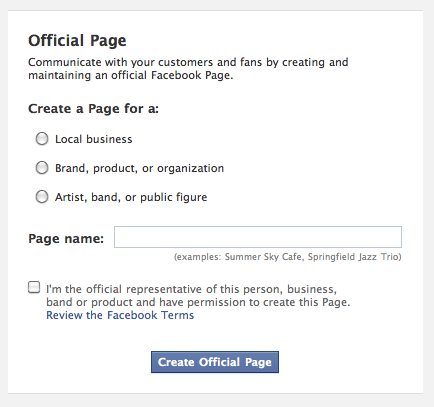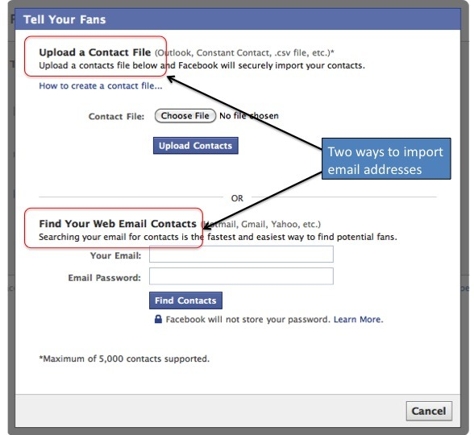One of the most-loved songs associated with the yuletide season is “The Twelve Days of Christmas.” In an effort to pay homage to the song and the season, here are 12 ways to market your ecommerce business using Facebook, during Christmastime or at anytime.
1. Create a Facebook Page
Creating a Facebook Page for your ecommerce business should be priority number one. This is where you establish a digital outpost within the social network. It opens the doors to many of the activities that follow on this list.
Setting up a Page is as simple as going to Facebook.com/pages, choosing Official Page (as opposed to a Community Page), selecting the business category and giving your Page a title. (Facebook uses the term “Official” to designate that the person setting up the page is an official representative of the organization.)

Choose ‘Official Page’ as the option when setting up a Facebook Page.
It’s one thing to create a Page and another to build something that distinguishes your business from competitors and attracts the attention of prospective Fans. A Page that lacks customization is akin to a Christmas tree without ornaments.
One way to “adorn” your Page is by creating a custom “welcome” tab which serves the same or similar function as the home page of your website. In fact, you should think of a Facebook Page as a micro-site that includes a number of tabs: Welcome, About, Contact and, as will be discussed below, a shopping cart.
Creating such a page is not difficult thanks to third-party Facebook applications designed to alleviate the need to know FBML, Facebook’s coding language. Here’s a short-list of some I have used or experimented with:
- SplashTab
- Shortstack
- TabSite
- FanPageEngine
- FaceItPages
- PageLever
- Tabfusion
- Pagemodo
- North Social
For more information about these apps, review my previous Practical eCommerce articles on those topics:
Here are a couple of examples of Pages created by smaller ecommerce merchants that contain the types of tabs to which I refer:

Bullsifashion Facebook ‘Welcome’ Page.

Rags Land Retail Clothing ‘Welcome’ Page.
2. Create an Alias
Once your Page has reached 25 Fans, Facebook allows you to create an alias — also known as a “username” or “vanity URL”. In essence it turns the URL http://www.facebook.com/pages/practicalecommerce/21252163696 into http://www.facebook.com/practicalecommerce.

Facebook Alias (Vanity URL) option; choose wisely.
If your Page has reached that threshold, go to Facebook.com/username to reserve your alias. Facebook will confirm the name is available and, if so, gives you the option to select it. A word of warning: You will not be able to edit or transfer this username once it has been set. Therefore, make sure you are certain of your selection before committing to it.
3. Create Interesting Content
When you create a Facebook Page, what you are really doing is building a community of people who have expressed affinity for your brand. But, just because they click the Like Button does not mean they will frequent the site with any degree of regularity. That’s where the job of creating engaging, informative or entertaining content comes into play. As the page owner, you have to give them a reason to return, and in this case, “content is king.” That content can take the form of status updates, video and photo uploads, polls, contests or special offers. It’OK to post information about your products from time to time, for they are often the reason someone becomes a fan in the first place.
One ecommerce merchant that does a good job with content creation is Well.ca, a health and beauty products online retailer based in Canada. The company updates the page several times per week with content ranging from product-related posts to behind-the-scenes photos to questions designed to encourage fan response.

Well.ca Facebook Page posts.
One benefit to posting regularly is that your content gets syndicated to news feeds on your Fan’s personal profiles. That can translate into greater top-of-mind awareness about your brand, increased traffic to your page and growth in the number of Fans.
4. Engage with Fans
Once Fans begin to respond to your content, engage them in active dialog. Task someone with the responsibility of keeping tabs on comments from Fans. Ideally, that person needs to be someone within your organization.
This process does not have to be as arduous as it may sound. Tools are available to streamline it, and we addressed some of them in “5 Timesaving Social Networking Tools.”
5. Add a Facebook Shopping Cart
Facebook is taking proactive steps to turn ecommerce into “f-commerce.” (See “Facebook Ramps Up Big E-Commerce Drive” at Bloomberg Businessweek.) One of the ways that is being done is via the inclusion of shopping carts. Recently, retailer JCPenney set up a full-blown cart within its Facebook page containing all of the same products that are available on the company website.
A number of such carts are available for use by smaller merchants and we have written about them previously here at Practical eCommerce:
- “Six Facebook Applications to Sell Your Products”
- “Social Commerce: Shopping Carts Extend Reach Into Facebook, Other Social Sites”
- “Facebook Encourages Ecommerce; App-Makers Respond”
6. Advertise to Increase Likes, Drive Traffic to Website and Promote Products
Recently, Facebook made changes to its profile layout and made ads more of an integral part.

New Facebook Profile layout integrates ads.
Most likely, this is due to the fact that income from such ads has become a greater percentage of Facebook’s overall revenue model. Where ecommerce merchants are concerned, that is not a bad thing. Facebook advertising is being taken more seriously by merchants who are seeing measurable results for their efforts.
One such merchant, Dale Traxler, owner of Beaded Impressions and , recently wrote about his use of Facebook Ads in the blog post “Is Facebook Really Worth It?”. “Facebook delivered as many measurable sales dollars this month as Yahoo and Bing. And, we are building better brand loyalty in Facebook than we ever had a chance to do in search engine marketing,” Traxler said.
Facebook’s advertising platform works like Google AdWords in that it is a self-contained, pay-per-click, bid-based system. Two distinct advantages to using Facebook Ads, compared to Google’s AdWords, are that it is extremely inexpensive and provides for a much greater degree of targeting. Not only that, but ads are often “social” in nature as they indicate which of your friends have Liked the ad.
7. Send an Email Invitation
Facebook now allows page administrators to upload a mailing list to invite list members to “Like” the page. Go to the “Marketing” section of the Page administration panel and look for the “Tell Your Fans” option. You can upload addresses from Outlook, Constant Contact, or almost any source that contain a list of contacts, including web-based email platforms such as Hotmail, Gmail and Yahoo!.

Facebook Page email invitation feature – Tell Your Fans.
8. Send Updates to Fans
Facebook is acting increasingly like an email marketing platform in that it allows email broadcasts to be sent to Fans. Messages can be sent to all Fans, or segments, based on location, gender and/or age. Go to the “Marketing” section of the Page administration panel and look for “Send an Update.”
Facebook does not presently allow HTML messages, but plain text only. Still, it can serve as a adjunct to traditional email marketing. Facebook also archives past updates, so you can keep track of messages that have been sent.
9. Get a Facebook Badge
Facebook offers several “badges” that you can add to your ecommerce website: Profile badge, Photo badge, Like badge, and Page badge. More than likely, you would choose the Page badge. You can access this option via the “Marketing” section of your Page admin panel as well.
10. Add a Like Box or Button to Your Website
Similar to badges, Facebook also has a number of what it calls “social plugins,” embeddable social features that can be integrated in your site with a line of HTML code. One of most popular is the Like Box, a plug-in that enables Facebook Page owners to attract and gain Likes from their own websites. Site visitors can see how many users already Like the page and which of their friends Like it, too, and read recent posts from the page and Like the page with one click, without ever leaving the website.

Add a Like Box or Button to your website.
If it seems that a Like Box would require too much real estate on your website, use the Like Button instead. There are a number of options for the Like Button, including the ability to include the names and profile pictures of users’ friends who have also liked the page. You may want to consider using both, the Like Box on your home page and Like Buttons on each of your product pages, so customers can express their affinity for a given product.
11. Add ‘Recommendations’ Box to Your Website
“Recommendations” is another plug-in that can be used to integrate Facebook into your website. It provides personalized recommendations to your users. To generate the recommendations, the plug-in considers all the social interactions with URLs from your site. For a logged-in Facebook user, the plug-in will give preference to and highlight objects his or her friends have interacted with, according to Facebook.

Recommendations are another way to integrate Facebook into your site.
12. Use Facebook’s New Registration Tool
A new entrant into Facebook’s arsenal of social plug-ins is a registration tool that gives website owners the ability to offer quick, easy and social options for sign-up. This is an alternative to Facebook Login (formerly known as Facebook Connect) and can be used as an option for site visitors who do not have a Facebook account or when your site needs additional information that Facebook doesn’t provide. It is an HTML form that can be used in addition to, or as a substitute for, your current website registration form.

Facebook has new registration tool.
The registration tool is an iframe that websites can add with just one line of code, and can be customized to request specific fields required to create an account. Facebook users will see that the form is pre-populated with the relevant information they have shared on their profiles.
Conclusion
Facebook offers many ways to market your business during the holidays and throughout the year. If you don’t already have one, a custom Facebook Page is the place to start.





